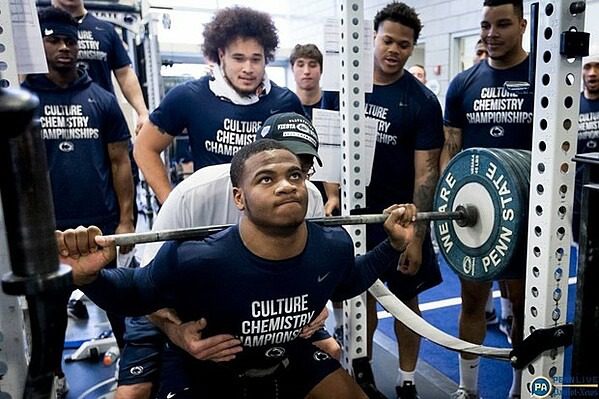Tech and the Fundamentals
Coach DevelopmentABOUT THE AUTHOR

adam dawdy
Adam Dawdy is a Product Manager at TrainHeroic. Before that, he coached in various settings, taught, and studied biomechanics and exercise physiology. Adam is a converted endurance athlete who enjoys the pursuit of strength.
On July 14th, TrainHeroic took part in the PLAE xLab at Colorado State University in Fort Collins. PLAE’s events are based on different themes. This one was focused on technology. Speakers from UCLA, Clemson, Rutgers, and the University of Oregon talked about their experiences with various pieces of tech – from force profiling to GPS.
I’ve been to a handful of conferences recently, and whenever technology or sport science comes up nowadays, it’s met with healthy doses of realism and skepticism. Cool. Your widget can do some neat things. So what? How does it actually work in practice? We’re getting past going gaga over bells and whistles.
With some of these modern tools having been on the market for years now, there is a growing body of practitioners who have actually used these things in their programs. They’ve seen the good and the bad. Hearing about how they’ve come to use different tools is very enlightening and helpful.
But the real takeaways are…much more fundamental
// Culture
If you’ve been to many conferences, you know that while the scheduled content can be helpful, the real value of conferences is in understanding the experiences of other people. I’ve always learned the most from the little side conversations that happen.
The PLAE xLab, despite being focused on technology, was no different. It was evident that the attendees kept their focus on the problems they actually face, and how to solve them. It’s easy to get distracted and enamored by the next big thing, but technology should be helping you solve problems. Since many of the coaches in attendance were at smaller programs with less funding, they’re generally not as concerned with how to use a Catapult or Sparta Science system. It simply isn’t accessible. That’s not to say they may not be able to take some learnings from talks on these tools, but they have more immediate concerns.


One great gem of this conference happened in a breakout discussion. One of the speakers, Michael Bewley of Clemson University, was asked, “How do build a better culture?” by a young strength coach. The response: “What is your culture? Can you define it?”
He’s right, of course. You can’t just treat “culture” as an abstract entity and leave it at that. If you were to ask your athletes what their team is all about, would they be able to tell you? If not, why?
It’s important for a group to have a set of unifying principles and values. If you look at successful, cohesive groups, from football teams, to special forces, to Boy Scouts, to religious groups, one thing they will have in common is a shared vision and enumerated values or principles that everyone in the group can identify and list out.
Your weight room shouldn’t be any different. If you can’t talk specifically and concisely about your group’s values, how can you expect anyone else to? If you want your athletes to live your principles, it helps if everyone actually knows what those are.
// Engagement
Coach Ryan Davis and his staff at CSU use TrainHeroic for all of their weight room programming. They have an amazing setup at their new facility, including iPads at each rack. They really have their system dialed in and running smoothly; I’ve always come away impressed and enthused when I’ve watched these guys train.
For the PLAE xLab, TrainHeroic and CSU teamed up to give a simple demo and experience to help the coaches in attendance see how a solution like TrainHeroic actually looks and feels in real life.
One feature we have in TrainHeroic is the leaderboard, which lets you program a block for athletes to compete on. I thought it’d be fun to have a little friendly competition. I won’t lie. I spent way too long trying to come up with some kind of cool competition that would get people fired up. I was missing the point. I realized that I had been gifted the perfect storm of environment, culture, and participants for something really simple to succeed. I had:
- Coach Davis and his staff setting the tone. There are just some people who get you fired up and make you want to follow. He’s one of them.
- A room full of coaches who were engaged enough and motivated enough to spend a Saturday to learn.
- A great weight room with a smart setup.
So, I threw in a leaderboard for max pushups in a minute. It sounds simple, but because everything else was right, it took on a life of its own. Just check this out:That atmosphere! Who wouldn’t give their best in that situation?
Give competitive people in a supportive environment a chance to compete, and they’ll get after it.
// What’s The Point of Technology?
The point of all this, which I said to the group when introducing the demo, is that technology is only any good to you if it actually solves a problem.
In the case of this demo, I had a bunch of people willing to try hard, and they were being held accountable by their peers. The leaderboard is just a tool to help you bring out the best in your athletes. It won’t replace your culture or the shared values your culture is based on, but it can facilitate you and your athletes being your best.
Are you a better coach after reading this?
More coaches and athletes than ever are reading the TrainHeroic blog, and it’s our mission to support them with useful training & coaching content. If you found this article useful, please take a moment to share it on social media, engage with the author, and link to this article on your own blog or any forums you post on.
Be Your Best,
TrainHeroic Content Team
HEROIC SOCIAL
HEROIC SOCIAL
TRAINING LAB
Access the latest articles, reviews, and case studies from the top strength and conditioning minds in the TH Training Lab

